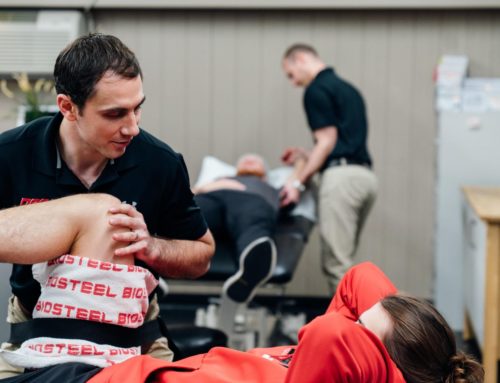Proper motor coordination is the primary goal of a rehab program and requires:
- Pain reduction
- Adequate range of motion (ROM) from joints and soft tissues
- Strength and endurance of smaller stabilizing muscles that are close to the joints
This will allow for larger muscles that are farther away from joints (prime movers) to create smooth efficient movement from the correct areas.
Proper motor coordination is when your BRAIN gets the correct muscles to stabilize joints through the correct range of motion while using the correct muscles produce the movement. If there is pain, reduced motion or weakness, the body will compensate leading to future injury or ineffective rehab.
Assessing all these areas will guide an individualized treatment plan to correct a patients unique issues.
Eliminating pain is the first step in rehab because pain can cause our brain to stiffen up or turn off muscles in an attempt to protect the damaged area. This compensation results in overloading of surrounding joints and muscles and altered motor control. If there is pain and we try to strengthen a muscle that our brain has turned off, we will over continue to stress surrounding areas and perpetuate the compensated movement. OR, if there is pain and we try to stretch a muscle that is guarding we will not improve tissue length. It’s not just short, its tight because it is guarding a painful area.
The nervous system’s primary function is survival so if there is pain or a perceived threat, it will do whatever it can to eliminate the threat (compensate) without worrying about tomorrow.
When the pain is gone, we will be much more successful in restoring proper tissue length with soft tissue techniques and stretching.
When we start strengthening, we start with simple neurological exercises. This means we start from a non-postural position (usually lying on your back). Standing upright requires a lot of brain power that we don’t realize, so lying on your back to re-learn how to activate a muscle will help you learn a motor pattern correctly. This is why we practice the movement lying on your back, before trying the same motion in a more difficult position.
Re-training shoulder stability example:
- Supine Y
- Quadruped Y
- Half Kneeling Y
- Half Kneeling Y with TS Rotation.
These stages are all blurred and many areas can start to be addressed at the same time to speed up recovery as much as possible. If there is pain or if you are attempting an exercise too early, you will likely lengthen your recovery time and perpetuate motor pattern dysfunctions (getting better at moving wrong). See a rehab specialist at the first sign of injury or dysfunction to get yourself on the correct rehab plan so you don’t waste time doing the wrong things.
Written by: Dr. Jeff Smeaton, Chiropractor, TPI Certified Golf Medical Professional






